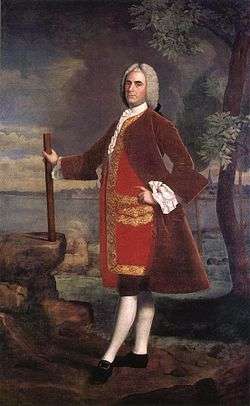Northeast Coast Campaign (1747)
| Northeast Coast Campaign (1747) | |||||||
|---|---|---|---|---|---|---|---|
| Part of King George's War | |||||||
 Commander Samuel Waldo | |||||||
| |||||||
| Belligerents | |||||||
|
|
Wabanaki Confederacy | ||||||
| Commanders and leaders | |||||||
|
Commander Samuel Waldo (Falmouth)[1] Captain Jonathan Williamson | unknown | ||||||
| Strength | |||||||
| 625 | unknown | ||||||
| Casualties and losses | |||||||
| approximately 30 persons killed or captured | unknown | ||||||
The Northeast Coast Campaign (1747) was conducted by the Wabanaki Confederacy of Acadia against the New England settlements along the coast of present-day Maine below the Kennebec River, the former border of Acadia. during King George's War from July until September 1747. They attacked English settlements on the coast of present-day Maine between Berwick and St. Georges (Thomaston, Maine), within two months there were 11 raids - every town on the frontier had been attacked.[2] Casco (also known as Falmouth and Portland) was the principal settlement.
Background
After the two attacks on Annapolis Royal in 1744, Governor William Shirley put a bounty on the Passamaquoddy, Mi’kmaq and Maliseet on Oct 20.[3] The following year, during the Campaign, on August 23, 1745, Shirley declared war against the rest of the Wabanaki Confederacy – the Penobscot and Kennebec tribes.[2] In response to the New England expedition against Louisbourg which finished in June 1745, the Wabanaki retaliated by attacking the New England border.[4] New England braced itself for such an attack by appointing a provisional force of 450 to defend the frontier. After the attacks began they increased the number of soldiers by 175 men.[4] Massachusetts established forts along the border with Acadia: Fort George at Brunswick (1715),[5] St. George's Fort at Thomaston (1720), and Fort Richmond (1721) at Richmond.[6] Fort Frederick was established at Pemaquid (Bristol, Maine).
After the Northeast Coast Campaign (1745) and 1746), the 1747 followed.
The campaign
Wabanaki Confederacy began their first raid on April 13 at Scarborough, killing two and taking four prisoners.[7]
A militia of 50 natives raided Falmouth on April 21, killing cattle and attacking Mr. Frost’s family, taking captive his wife and six children.[7] Despite sending 26 men after then under Captain IIsley, they were unable to catch the native and their prsoners.[7]
Capt. Jordan’s company of 30 was posted from Falmouth to Topsham, leaving the town defenseless. The natives killed two women and a man. Crossing the Androscoggin in canoe, natives killed two men and wounded the third, one woman escaped.[8]
On 26 May, 100 natives attacked Fort Frederick at Pemaquid.[8] The killed five soldiers, five recruits and the other inhabitants were taken prisoner.
At Damariscotta, natives took one prisoner, killing his wife and child.[8]
At Wiscasset, the natives again seized Capt. Jonathan Williamson.[8]
At Fort Frederick in early September a company of 60 natives attacked. Killing five guards and then attacked for two hours and then withdrew.[9][10] At Fort Georges, naties tried, unsuccessfully, to dig a tunnel into the fort.[10]
Aftermath
Natives took Frances Noble captive close to Fort Richmond in 1748. Frances Noble wrote her captivity narrative.[11][12]
Natives also killed a number of British at Fort St. Georges in the fall of 1748.[13]
See also
Notes
- ↑ Folsom, p. 242
- 1 2 Williamson, p. 240
- ↑ Williamson, p. 217-218
- 1 2 Williamson, p. 239
- ↑ Fort George replaced Fort Andros which was built during King William's War (1688).
- ↑ The history of the state of Maine: from its first discovery, A.D ..., Volume 2, by William Durkee Williamson. 1832. p.88, 97.
- 1 2 3 Williamson, p. 251
- 1 2 3 4 Williamson, p. 252
- ↑ p. 127
- 1 2 Williamson, p. 254
- ↑ Samuel Gardner Drake (1841). Tragedies of the wilderness, or True and authentic narratives of captives who have been carried away by the Indians from the various frontier settlements of the United States, from the earliest to the present time... pp. 166–172.
- ↑ https://archive.org/stream/acg3054.0002.010.umich.edu#page/199/mode/1up
- ↑ p. 160, 163, 164, 172, 174
References
- "History of York County, Maine. With illustrations and biographical sketches of its prominent men and pioneers"
- Correspondence of William Shirley
- History of Saco and Biddeford: with notices of other early settlements, and ... By George Folsom
- The history of Portland, from 1632 to 1864: with a notice of previous By William Willis book
- William Durkee Williamson. The history of the state of Maine: from its first discovery, A. D ..., Volume 2
- Johnson, Michael; Smith, Jonathan (2006). Indian Tribes of the New England Frontier. Oxford: Osprey Publishing. ISBN 978-1-84176-937-0. OCLC 255490222.
